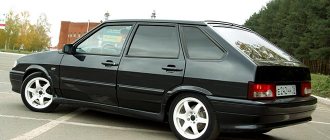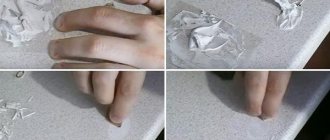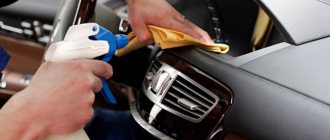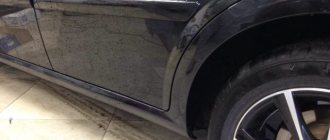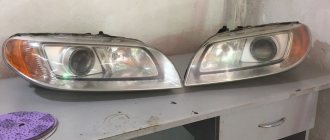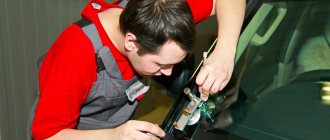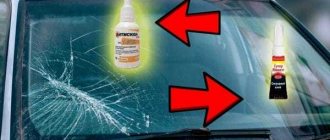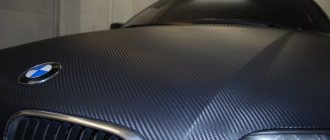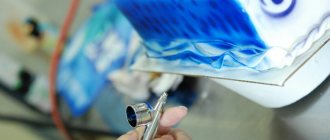Plastic products always cause a lot of trouble when painting. Polymer materials have a smooth surface, which is why the paint does not adhere well and begins to fall off quickly. Therefore, it is recommended to choose the highest quality formulations from the very beginning, so that fewer problems arise later. In this case, plastic primer provides reliable protection.
Is it easy to paint plastic?
The first requirement for a paint layer applied to a plastic surface is high adhesion to this surface.
But the fact is that initially, after casting, the properties of the plastic surface do not at all contribute to strong adhesion to the future paintwork, but quite the opposite.
The greatest difficulties when painting are created by the surfaces of non-polar plastics. They have a chemically inert, non-porous surface with low surface tension - and the lower the surface energy of the plastic, the worse its “adhesion” to the applied paints and varnishes.
Among all plastics, polypropylene and polyethylene have the lowest surface energy - these plastics and their modifications are considered the most difficult to paint.
When painting other types of plastics, problems associated with adhesion are not so pronounced, but this does not make it any easier for car repair workers, since polypropylene, as is known, is the most popular type of plastic used in the automotive industry. Almost all bumpers (and these are the main paintable plastic body parts) are made from various modifications of polypropylene - usually a dark gray material that can be soldered and is inert to solvents.
Try to take a polypropylene bumper and immediately apply paint on it - what will happen? A knowledgeable person will answer right away: nothing good... And indeed, the adhesive properties of the coating will be very weak. What should I do?
In the automotive industry, three main methods are most often used for the preliminary preparation of plastic before applying paintwork: corona discharge treatment, low-temperature plasma or gas flame treatment.
These operations are strikingly different from traditionally accepted surface preparation methods. For example, corona discharge treatment is the effect of an electric discharge on the surface being treated, generating “jet” of plasma. Plasma processing is carried out by exposing the plastic to a plasma flow generated by a plasma torch, and flame processing is carried out by the flame of gas burners.
The purpose of this treatment is to increase the wettability of the plastic surface, thereby improving its ability to form bonds with paints. In order for the surface to be well wetted by a liquid, the surface energy of the plastic must be higher than the surface tension of this liquid. If the surface tension of the liquid (paint) is greater, it will bead up instead of uniformly wetting the surface. Therefore, all processing methods are aimed primarily at increasing the surface energy of the polymer.
Wettability. On the left is the treated surface, on the right is the untreated surface.
As a result of this treatment, changes occur in the surface layer of the plastic: polar molecules are formed in the previously non-polar polymer, increasing the surface energy of the material. The surface at the micro level becomes rough, and its effective adhesion area to the paint increases.
There is no need to explain how complex and expensive the equipment is used for these processing methods. Its operation is justified only in large factories, in mass production, but for car service conditions all this is too expensive and complicated. For this reason, polypropylene has long been considered unpaintable.
Having put their brains to work, chemists have developed alternative, simpler methods for preparing polymer surfaces—the so-called “wet” chemical methods. The most convenient and used of them is priming the surface of the plastic. A special adhesive primer applied to the surface of the plastic serves as an effective intermediary between the polymer and subsequent coatings, and in some cases adhesion can even exceed the factory level!
Now let’s leave aside the complex chemical formulations and get down to business.
Why is a regular primer not suitable for plastic?
Plastic surfaces require priming more than others.
Plastic has features that distinguish it from other materials. The material is not perfect. In some parameters, plastic is superior to other materials, in others it is inferior to them. The high density of plastic elements made their adhesive properties worse. This affected the adhesion of paints and varnishes to the surface.
Painting on an unprimed surface will cause the paint to roll off and cause smudges. It is necessary to prime the plastic, otherwise painting will become impossible. The primer also allows you to repair minor inaccuracies or damage, which simplifies repair work.
Preparing plastic parts for painting
When starting to repair a plastic part, the first step is to determine what part we had to deal with. It could be:
- new part;
- old defective coating.
New plastic elements, in turn, can be supplied with factory primer already applied or in a “pure” form.
If you can't tell whether a part is primed or not, rub a small area of the part with some rough sandpaper such as P500. If there is sanding dust, then the part is primed.
There are minimal problems with primed parts, but we'll talk about that later. Now we are interested in the procedure for working with “clean”, unprimed plastic elements.
New unprimed part
Plastic parts are made by injection molding, and special lubricants are used during the production process to ensure that the part can be correctly separated from the mold after casting. Naturally, remaining on the surface of the plastic, they do not contribute to the adhesion of the paintwork.
There are two types of such lubricants:
- external,
- internal.
External lubricants are used in diluted form and sprayed into the mold before each new production cycle. They are not always applied, but every 3-4 times, so some parts have more lubricant, others have less. All these greases can be removed in a workshop environment with a suitable degreaser.
Internal lubricants are introduced into the composition of the plastic itself, so there is no need for separate spraying into the mold. Such plastics are more difficult to paint, since they themselves are “greasy”. The same polypropylene belongs to representatives of fatty plastics. Internal lubricants do not dissolve and are not removed by water, and they can be completely removed from plastic only by heating.
But one way or another, the first step to remove dirt from the surface of the plastic should be washing.
Washing
The ideal option in this case would be a high-pressure washer, but if it is not available, you can get by with a bucket of hot water with any active detergent (liquid soap, car shampoo) and some kind of brush or hard paint brush.
The part must be washed both outside and inside, and then rinsed with plenty of clean, warm water.
Evaporation
To be sure that no lubricants or dirt will interfere with the creation of strong adhesion with the future paintwork, according to the technology, the unprimed part must be heated in a chamber at a temperature of +60°C for 30-40 minutes. During this time, the lubricants located in the pores of the plastic will rise to the surface, where we will remove them with a cloth moistened with a degreaser. This should be done quickly, while the part has not yet cooled down.
If the part has a rough textured surface or is heavily soiled (for example, an old bumper), then it is advisable to repeat the evaporation process, and then repeat the procedure with a cloth and degreaser. To better clean such parts when degreasing, you can use Scotch Brite (gray).
In addition to removing lubricants, heating helps reduce internal stress in the plastic, which in the future can lead to unexpected cracking of the paintwork. Evaporation also helps to identify shrinkage cavities (air inclusions) and then remove them by puttying.
To save time and energy resources of the camera, you can load several plastic parts and warm them up at the same time.
In garages, doing the warming up trick can be quite problematic, so in such cases it is best to work with already primed parts.
Degreasing
Before the first grinding operation on plastic parts, whether preparing for priming or puttying, the surface of the part must be degreased.
In addition to cleaning the surface, this procedure also removes static charge from the part. This is important because when applying the primer, the dust, which usually flies off the surface, will quickly stick to the “charged” plastic, as a result of which the primer will not be placed on a dry, cleaned substrate, but on an already dusty one.
For degreasing, it is advisable to use only branded degreasers, preferably special antistatic degreasers for plastic. They are not aggressive towards plastic and are excellent at removing static charges.
It is recommended to degrease a new plastic element both from the outside and from the inside.
Matting
To prepare a new, undamaged plastic element for priming, it is enough to matte it with Scotch Brite or a similar material. For hard types of plastic, red (Veryfine) Scotch-Brite is recommended, and for soft/elastic types, gray (Ultrafine) is recommended.
Matting can be done both dry and with water. If a matting paste is used, after it you need to thoroughly rinse the part with plenty of warm water - the remaining paste can interfere with normal adhesion to the paintwork material (and this is exactly what we have been struggling with so far).
If the surface has minor damage received during transportation (for example, shallow scratches), then they are sanded using a grinder and abrasive wheels P320-P400-P500, after which the rest of the surface is treated with Scotch Brite.
After grinding, the part is degreased again.
Padding
A simple rule will help us solve the problem of paint adhesion on plastic surfaces once and for all. As a primary primer, a special adhesive primer for plastic (also known as a primer, adhesion activator) must be applied to clean (unprimed) plastic.
This primer is most often a very liquid transparent material with small metallic additives (to control application). It is usually made on the basis of polyolefin resins. The thickness of the layer of such soil is minimal - only a few microns. Most of these primers are single-component, although there are also 2K primers.
Such primers have been developed primarily for use on plastics of the polypropylene group (PP/EPDM, PPC, PPE, PPO, etc.), but most of them can also be used on many other types of plastics: ABS, PA, PC, PVC, PRO , PUR, fiberglass (GFK, BMC, SMC), etc. Modern primers have virtually no restrictions on types of plastic, with the possible exception of pure polyethylene (PE).
To improve properties and guarantee paintability, plastic body parts (fenders, hoods, bumpers, etc.) are produced in a modified form, which means they can be painted, despite the fact that they are sometimes labeled as PP and PE. In fact, unmodified polyethylenes (PE) and polypropylenes (PP) can only be dyed after activation by a gas flame or corona discharge. Otherwise, adhesion will be very weak! Various tanks and other expansion containers, disposable tableware, etc. are made from “pure” PP or PE.
Primers are available in both cans and aerosol cans. Aerosol primer is very convenient for minor repairs, for example, when, when sanding a bumper, small areas were sanded down to plastic. The release form in a can allows you to avoid wasting time on preparing the soil for spraying from a spray gun and on its subsequent washing. Just remember to shake the can vigorously before use.
The primer is applied in one or two thin, even layers with a wide spray over the entire surface of the part. Be careful when applying! Since the soil is very liquid, beware of the possible excess of the application thickness and runoff of the soil (this is most likely at the ends and stiffeners, along the perimeter of the part). A significant excess of the layer thickness can impair the adhesion of the entire coating and lead to “compression” of subsequent layers of paintwork.
Also keep in mind that after application, the primer changes the chemical state of the substrate only for a certain time, during which time you need to apply the next material. Therefore, to achieve the best adhesion, subsequent layers of the system should be applied after 15-20 minutes.
Most primers can be immediately covered with topcoat, but to increase resistance to chipping, it is recommended to additionally apply a layer of acrylic leveling primer to the surface, after adding the required amount of plasticizer to it, depending on the hardness of the plastic.
Just remember that it is not advisable to apply such thick layers of filler primer, as when repairing metal surfaces. Plastic is an elastic material, so a layer that is too thick may not withstand the effects of deformation and mechanical stress during operation.
After applying the filler - painting. Either “wet on wet”, if the soil allows it, or with intermediate grinding of the soil.
By the way, in addition to classic primers, many lines also contain universal primers for plastics, combining the properties of both a primer and a filler with a plasticizer. They have good adhesion to plastic and at the same time allow you to level out minor irregularities (for example, small marks from abrasive grinding). Such primers do not require the preliminary use of an adhesion activator, and thus allow, in some cases, to save an entire layer and operation.
About epoxy primer
By analogy with the repair of metal parts, where anti-corrosion primers act as an adhesive intermediary between the surface and subsequent layers of coating, an appropriate adhesive primer is applied to plastic for the same purpose.
In this regard, I would like to say a few words about epoxy primer.
Although epoxy primer is intended primarily for application to metal, its high adhesive properties make it possible to use this material as a primary material on some types of plastics. But only on some, since this soil does not have sufficient elasticity, and a plasticizer is not used with it.
But if you are repairing hard plastics, such as fiberglass or Carbon fiber, applying epoxy as the first layer of the system on these plastics is not only acceptable, but even recommended. Its adhesion to the surface will be excellent!
New primed part
Practice shows that the quality of factory primer applied to plastic parts can vary greatly from case to case. There are usually no problems with original parts, but the primer on parts of dubious origin can easily have poor adhesion or increased sensitivity to solvents. It’s easy to check: take a napkin or rag soaked in solvent and apply it to the part for a minute or two.
If the coating has softened, it must either be completely removed mechanically (P150-P240-P320), or a layer of insulating primer must be applied, having previously treated the part with gray Scotch-Brite, and then painted.
If a satisfactory test result is obtained, conventional technology is used. The part is degreased, matted, degreased again and painted. For matting you can use:
- gray scotch-brite (ultrafine);
- abrasive material gradation P400-P500 (when working with a dry grinder);
- material grade P800-P1000 (when working manually “wet”);
Before starting any work, the part must be thoroughly washed and dried, and before the matting operation, as well as after it, it must be degreased.
Damaged plastic element
By repairing a damaged plastic part we mean repairing various scratches, dents, chips and similar minor damage to paintwork. We will talk about more complex cases of restoring plastic parts, such as cracks or significant deformations, in a separate article.
Before starting work, a standard set of procedures is performed: the part is washed, dried and degreased. The next step is to prepare the damaged areas for puttying.
Grinding
Before you start filling damage on a plastic part, the paintwork from the surface of the defective areas should be removed - this will avoid defects such as peeling and sagging of the putty.
An eccentric sander and a P180 abrasive wheel are suitable for sanding damaged areas.
When sanding, try to avoid excessive pressure and high speed. Remember that thermoplastics begin to melt when heated.
Puttying
Filling damage on plastic surfaces is necessary with special plastic putties that have high elasticity and adhesion to plastic surfaces.
These putties are fine-grained, dry quickly and are easy to sand. Due to the fact that the putty itself already contains plastic, the two materials (the substrate and the putty) have similar properties, and react equally to sanding and wear out equally. Therefore, the boundaries between them are perfectly zeroed and are not outlined after priming.
The putty is usually applied directly to the sanded surface of the plastic, without requiring the prior use of any primers.
Try to keep the volume of putty to a minimum. Chips, scratches, places of soldering, gluing, small dents are welcome, but completely filling up planes on a plastic part is quite a risky task.
As for large deformations, on most plastics they can be restored quite easily by heating with a heat gun or IR drying and squeezing out. But this is if the part did not crack during deformation. Reinforced fiberglass plastics break in almost all cases.
And one last thing. The use of liquid putty when repairing plastic parts is excluded, no matter how difficult the repair may be.
Sanding putty
Plastic is many times softer material compared to metal. If you process metal and plastic with an abrasive material of the same gradation, say P100, then the roughness parameter on these two surfaces will be significantly different: grinding marks on soft plastic will be more pronounced and deeper, with a larger number of burrs. Therefore, it is obvious that when working with plastic parts it is necessary to use abrasive materials of finer gradations.
For processing putty, suitable gradation wheels are P150 (or P180 for soft plastics) and P240, used sequentially. After the putty is completely leveled, the boundaries of the repair area are treated with P240-P320 materials.
When processing plastic elements, whether removing paintwork or sanding putty, it is not recommended to use an abrasive coarser than P150-P180. If the plastic begins to fray during the sanding process, this indicates that the gradation used is too coarse.
Let me remind you once again that you cannot work on plastic parts at high speeds and with strong pressure when using a grinder - this entails overheating and subsequent deformation of the plastic.
Padding
It all depends on the materials used. There are two options: either we apply an adhesion activator, and then a 2K primer-filler with the addition of a plasticizer, or immediately a special universal primer for plastic (1-2 layers).
Before priming, do not forget to remove dust and degrease the surface.
Soil grinding
When processing the primer, standard technology is used: first, the primed area is leveled by hand with a sander and an abrasive strip, for example P320, after which final processing is carried out using a grinder and P400-P500 wheels. When working in wet conditions, materials graded P600-P800-P1000 are used respectively.
In the case of partial painting, the area around the repair area (or the entire remaining element in the case of complete revarnishing) is treated with gray Scotch Brite using matting paste or P800-P1000 material using a dry sander. Read more about this here.
Hard-to-reach areas are treated with an abrasive sponge (P600-P800) and/or gray scotch-brite (Ultrafine).
How to apply primer
The technology for applying the priming composition is important, since the final result depends on compliance with the priming rules. To ensure that the primer lays down perfectly and ensures maximum adhesion, work is carried out in the following sequence:
- Washing and cleaning the plastic surface from dirt and dust.
- Clean the plastic with sandpaper.
- Degrease the base.
- Use an antistatic agent to prevent dust from sticking.
- Cover the surface with the first layer of primer. Spray with aerosol or apply primer with a brush.
- Wait for the first layer to dry (10-15 minutes). Apply another 2-3 layers of coating.
Since the primer for plastic dries, the part is ready for painting within 15 minutes after coating with the last layer.
It is also better to apply the paint composition in several layers so that it is uniform and homogeneous.
Painting plastic parts
There is no point in going into detail at this stage, since painting a primed plastic surface is no different from painting a similar metal surface. Just don’t forget about adding the required amount of plasticizer to 2K paint or clear varnish.
But it’s worth taking a closer look at plasticizers and some other additives.
Plasticizers
It is necessary to add a plasticizer to standard 2K acrylic primers, enamels and varnishes for two reasons. Firstly, the additive gives the material elasticity, which means the paintwork will not crack when the plastic is deformed.
Secondly, when the temperature of the plastic surface changes, the paintwork will expand and contract at the same rate as it.
You can often notice microcracks on bumpers located in places that seem completely unaffected by deformation. The appearance of these cracks is due precisely to the thermal expansion of the plastic and the lack of plasticizer in the repair materials.
The coefficient of thermal expansion of plastic is much higher than that of metal. Therefore, paints and especially primers, which have a very low coefficient of expansion, simply cannot withstand temperature changes without a plasticizer and crack.
The amount of plasticizer added is important, which is always indicated in the technical documentation for the product. This amount depends on the hardness of the plastic - the harder the plastic, the less plasticizer needs to be added. Conversely, the softer/flexible the plastic, the more.
For example, for painting an elastic bumper this amount can be 30%, for a soft polyurethane lining - 50%. When painting fiberglass, adding a plasticizer is usually not required.
No plasticizer is added to base enamels!
Mixing sequence
When adding a plasticizer, it is recommended to prepare the material in a certain sequence: first, a plasticizer is added to the base material, be it primer, enamel or varnish, and then a standard amount of hardener and, if necessary, a thinner are added to the total volume of the resulting mixture.
This sequence is due to the fact that the plasticizer also contains a binder that requires polymerization. And if a hardener is first added to the material, and then a plasticizer, this can negatively affect the drying, strength and performance characteristics of the coating.
Matting and structure additives
A well-polished varnish or top enamel has a smooth surface and excellent gloss. This is very good, but these qualities are not always needed.
For example, on some cars, the plastic parts may not be as shiny as the rest of the body. They may also have some texture. Plastic bumpers of SUVs are often painted this way; on many Mercedes, plastic linings have such a “rough”, grainy surface.
Such a surface can be imitated by special structural additives to 2K top coat enamels and clear varnishes. They are usually produced in two types: coarse (grob) and thin (fein). As a result of using a structural additive, the paintwork becomes matte and acquires the desired degree of roughness.
When adding structural additives, additional plasticizer addition is usually not required.
There are also additives that do not change the surface texture, but are intended solely to reduce the gloss level of the coating. Depending on the amount of additive introduced, the gloss level can be changed within a very wide range, achieving a different matte effect - from silky to completely matte.
Correct application of primer to plastic surfaces
The main thing is to take care of pre-cleaning of products before starting work. This applies to both old finishing materials and any kind of contamination. High-quality sanding is required in the case of glossy surfaces, regardless of the PVC primer.
High-quality sanding is required in the case of glossy surfaces, regardless of the PVC primer.
How to apply the adhesive mixture yourself
Fewer problems arise when primer is applied with acrylic. The same applies to modern aerosols. For high-quality surface preparation, 2-3 layers will be enough. The main thing is to let the previous layer dry before applying the next one. Then acrylic material gives better results.
The sequence of work is also quite simple when applying the adhesive composition:
- The plastic is cleaned and degreased. Otherwise, it cannot be used further.
- Use brushes or sprayers for application. One covering layer is enough to achieve the result, making it easier to paint later.
- The first layer dries approximately in 1 hour. Only after this time can you begin the next types of work.
- Level and matte the surface painted twice. This is most often ordinary plastic.
- The product is thoroughly dried; processing with a wet primer is unacceptable.
- The surface is thoroughly cleaned using a cloth with a solvent.
When all steps have been successfully completed, the product is painted. Adhesion is guaranteed for a long time.
For high-quality surface preparation, 2-3 layers will be enough.
Drying
To dry painted plastic, it is often recommended to be on the safe side using natural drying or a temperature not higher than 40-45°C. It is worth noting that such a recommendation is not without meaning. It is better to dry plastic longer than metal, but at a lower temperature. It should also be taken into account that the introduced plasticizers and other additives increase the drying time.
But still, with the right approach to repair, which we discussed today, there is no need to be afraid of more intense heating at 60°C. This will not cause any problems, and the quality of the coating will only improve.
Be careful with IR drying as you will not be able to control the surface temperature of plastic parts.
Primer for plastic – what are the features of working with this material?
In some cases, universal formulations are sufficient. Under other circumstances, you cannot cope without at least one layer of primer from an expensive series. Most people prefer two-component formulations that do the job best. But there are other nuances that deserve special attention when using an activator.
Most people prefer two-component formulations that do the job best.
The difference between plastic and other materials
Primer for plastic is used to protect paintwork from further peeling. But before use, you need to study the characteristics of the plastic itself. Its chemical composition results in significant differences from other modern materials. Here are features that deserve additional attention:
- No substances harmful to health. An exception is when exposed to high temperatures or other similar types of processing;
- High strength, although rigidity remains relatively low;
- Easy operation and handling for everyday use. Especially if it is an aerosol;
- Lack of protection from prolonged and severe exposure to fire;
- Long service life thanks to maximum weather protection;
- Ease.
Even versatile materials require this kind of life extension. A primer for plastic for painting will give the same result.
Primer for plastic is used to protect paintwork from further peeling.
About adhesion after painting
Another interesting feature of plastic is that the adhesion on it does not become quite strong immediately, but after some time. So don’t be surprised if an accidental scratch on a repaired bumper leads to further peeling of the coating. A few days will pass and adhesion will reach its normal parameters.
For the same reasons, try not to high-pressure wash a freshly painted plastic part for 3-4 weeks after repair.
Which primer to choose
When choosing a primer for plastic, be sure to consider the following nuances:
- the need to increase adhesive properties, product protection, or a combination of both properties;
- operating conditions of plastic products: humidity, temperature, exposure to precipitation;
- type of finishing coat and compatibility of paint and primer.
A high-quality primer for plastic is not cheap. Popular brands offering effective priming products set a price of at least 1000 rubles per 1 liter.
Utilities
Procedure for repairing plastic parts
Designations of the most common plastics
Classification of plastics depending on hardness
How to clean primer from plastic
When priming, sometimes it becomes necessary to wash off the remaining primer composition from the plastic. This must be done quickly and correctly, since if done incorrectly there is a risk of damaging the surface or leaving stains from the primer. The most accessible method of cleaning soil from plastic is vinegar essence. Since it has specific properties and odor, precautions should be taken: wear special protective clothing and ensure the room is ventilated.
Important! When cleaning plastic countertops and window sills, do not use acids, as the primer will melt and leave stains.
Also used to remove primer from a plastic surface:
- cleaner for polyurethane foam;
- window cleaner "Mr. Muscle";
- baking soda;
- fine-grained sandpaper.
You can also cover the contaminated area with a wet cloth. The soil will swell and can be washed away.
Priming in the case of plastic surfaces is a mandatory step. Without applying a primer, the paint coating will not adhere to the surface. Using the right primer will help create additional protection for plastic elements and ensure high-quality adhesion of the paint to the surface.
How to treat the primer for high-quality enamel application?
It should be remembered that the primer is applied only to a matte surface. If you are working on a glossy piece, use fine sandpaper. Simultaneously with the water supply, make the surface matte and prepare it for applying the necessary primer. You just need to apply the aerosol from a can, but canned materials are applied using a spray bottle and a compressor. You should also remember the following features of processing parts:
- after application, you need to wait until it dries completely; for different types of soil this will be a different period of time;
- Next, the soil for the plastic needs to be leveled - this is done in the same way as the process of matting plastic using sandpaper and water;
- then everything is dried well again; you should not allow enamel to be applied to a damp surface with a primer;
- before painting, it is also worth wiping the product with a rag or napkins soaked in solvent (degreasing and dust removal);
- After all these procedures, you can proceed directly to painting the parts using automotive enamel.
Every professional painter has his own idea of how best to prepare the primer for applying other paints and varnishes. But if you do not carry out the preparatory work, the surface and paint layer will not be of high quality. This will bring certain problems for the appearance of the car. The primer will be uneven, unpleasant flaws will appear, which are very noticeable during the operation of the vehicle.
About foam processing
The use of a primer is mandatory when external work is carried out on the facade. But the material itself is not applied directly to the foam, but to the surface that will be finished with insulation.
Deep penetration acrylic primer is used for walls that will be finished with foam plastic in the future. Thanks to this, the structure has an increased shelf life and receives additional protection from destruction ahead of time. 1 layer is enough if brick is primed under the foam. If the surface is porous, then at least double processing will be required.
Primer is required for any foam products located outside or inside the house. The main thing is to apply the composition directly to the plaster. The putty should be applied to the base in a very thin layer. After this, you need to wait until the decorative element is completely dry.
